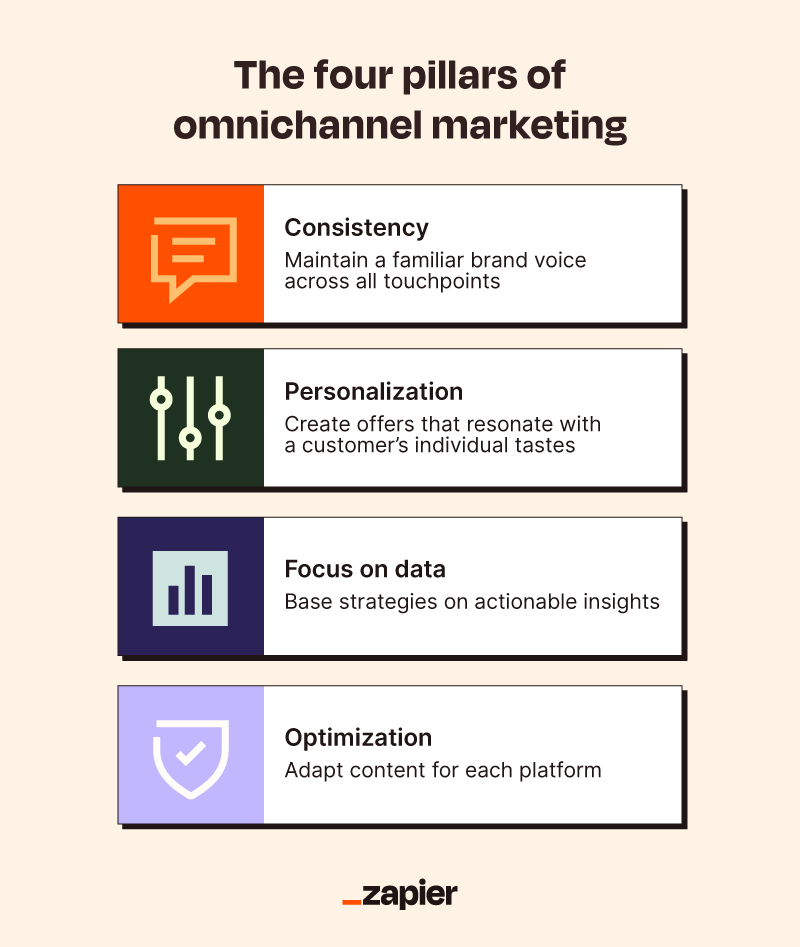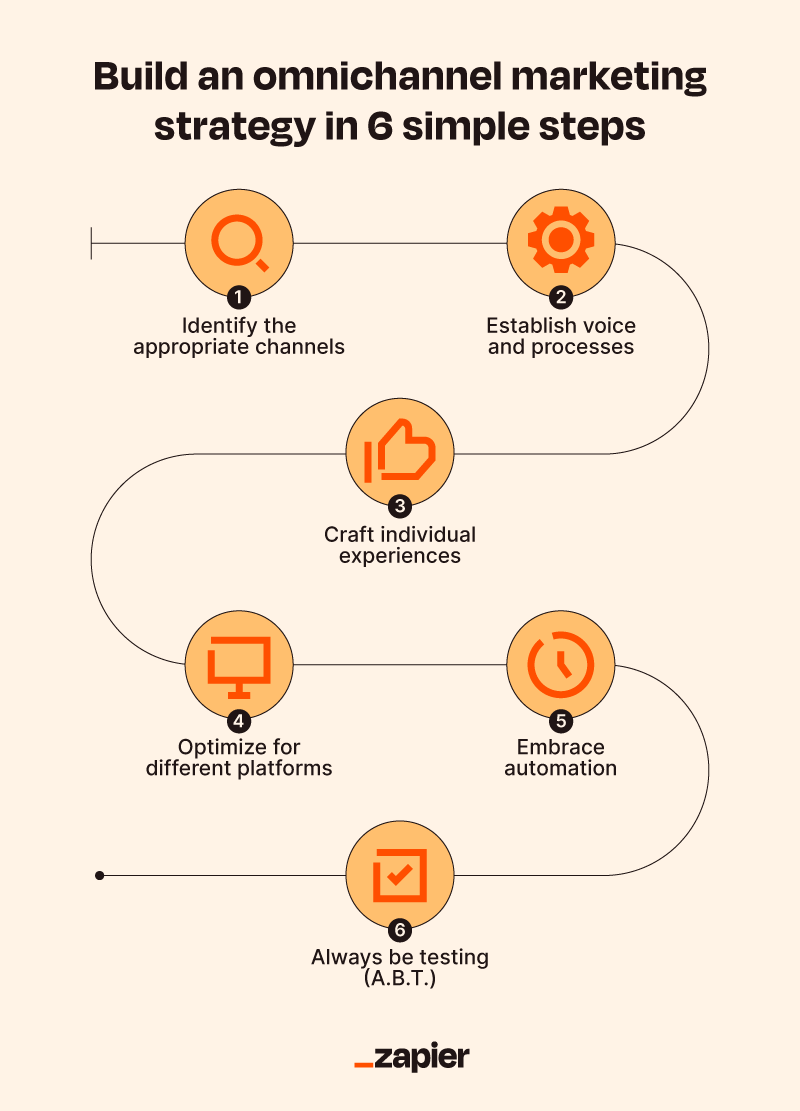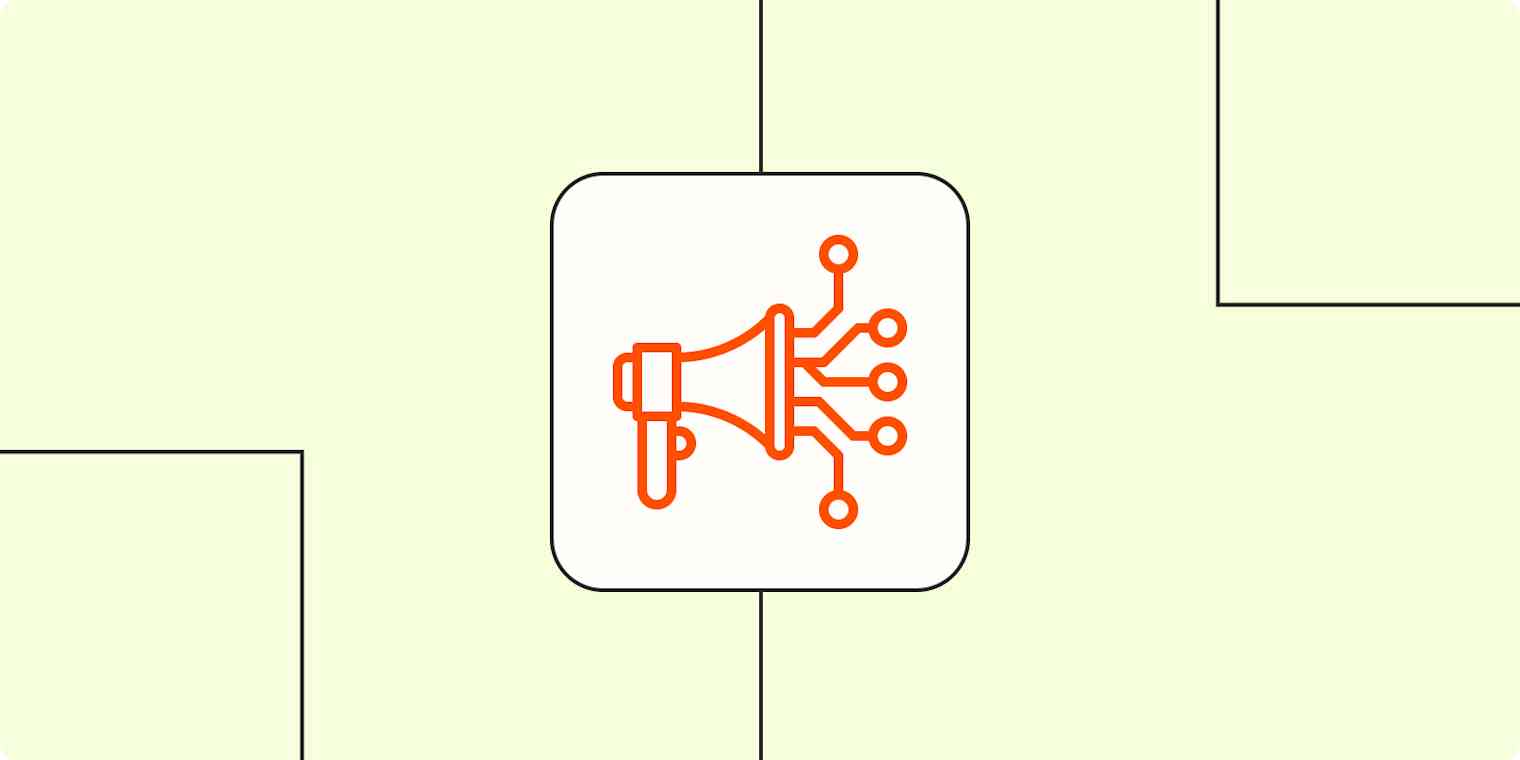Like so many, I caught the pickleball bug last year. And when it was time for a paddle, a quick search led me to PaddlePrestige's site. I browsed and put my email in for a discount, but left empty-handed. Then it happened. PaddlePrestige was suddenly in my inbox, on my social feeds, and even in influencer posts. Eerie? Maybe—but it worked like a charm.
Now, every weekend, you'll find me at a pickleball court with my PaddlePrestige in hand. What sealed the deal? A killer omnichannel marketing strategy. They met me where I was—online and in my thoughts—and transformed me not just into a customer, but an actual fan.
Table of contents:
What is omnichannel marketing?
Omnichannel marketing is a customer-centric approach to business that uses all marketing channels to reach customers.
It's like having your brand consistently whisper in your customers' ears, no matter where they are—just more appropriate and less reminiscent of the Lost smoke monster. And no matter what channel they find you through, they're receiving a consistent brand experience.
What is a marketing channel?
A marketing channel is a platform a business uses to convey its message, showcase its products, or engage its customers. Think: paid ads, blog content, email campaigns, or social media posts.
Below is a comprehensive list of marketing channels your business can leverage in an omnichannel strategy.

The four pillars of omnichannel marketing
Now, just because you can tap into all of these channels, doesn't mean you should. Omnichannel isn't about bombarding customers from every direction; it's about creating a harmonized journey across all of these touchpoints. To do that, you'll need a complete understanding of the four pillars of omnichannel marketing.
Consistency: Your brand needs unified communication, no matter the touchpoint. Joe from Des Moines should feel like he's interacting with the same brand, whether he's on your Instagram page while waiting for his plane or in your physical store down the street from his house.
Personalization: Joe wants those sneakers in neon green? Remember that. And maybe suggest matching neon laces next time. Omnichannel is about tailoring the experience to each customer's wants and whims.
Focus on data: Gone are the days of throwing things at the wall and hoping something sticks. Every decision in this realm is backed by cold, hard data. What are your customers clicking on? What are they ignoring? Know it. Use it.
Optimization: Just because you distribute a unified message across channels, doesn't mean it's easy to copy and paste. Content still needs to fit the platform it's on, so your snazzy Instagram post might need a tweak for it to shine in an email campaign.

Why is omnichannel marketing important?
Omnichannel marketing marks a paradigm shift in how businesses engage with their customers. It aligns with modern consumer behavior, where consumers are consumers all the time and have high expectations for personalization. It optimizes opportunities for engagement and positions brands to be more competitive and customer-centric.
Here's why giving omnichannel marketing a seat at your strategy table isn't just a good idea, but a necessity:
Unified customer experience: Customers interact with brands across all sorts of platforms. Uniformity across these platforms fosters trust and makes brand interactions predictable and reliable.
Tailored engagement: Customers demand personalization. They're more likely to engage with a brand that "remembers" them.
Increased revenue opportunities: By offering a seamless experience across channels, you increase the potential touchpoints and lead customers further down the sales funnel.
Expanded brand reach: While one customer might be active on social media, another might prefer emails or in-store experiences. Being present across multiple platforms ensures you reach your audience wherever they are, maximizing brand exposure.
Enhanced customer satisfaction: A smooth, frictionless journey from discovery to purchase (and beyond) across channels naturally leads to happier customers.
Operational efficiency: Integrating multiple channels can lead to better data integration, streamlined processes, and reduced redundancy, making marketing efforts more effective.
Competitive approach: As they say, adapt or die. Modern consumers expect and reward omnichannel experiences. Don't think your Google Ads spend is going to be enough to stay competitive.
Multichannel vs. omnichannel: What's the difference?
In the grand game of marketing lingo bingo, "multichannel" and "omnichannel" are both winners. Both play with multiple platforms, aiming to engage the ever-elusive and always-connected customer. But, like salt and sugar, they have different flavors and purposes.
Multichannel: Jack of all trades, master of none
Multichannel marketing means being everywhere your customer is, aiming to cast a wide net. It's marking your presence on every channel possible, from social media to emails to in-store promotions—but there's a catch.
While this strategy ensures visibility across a wide spectrum of platforms, it often lacks the cohesive and integrated experience modern consumers crave. Each channel might operate in its own silo, independent of the others, leading to potentially disjointed customer experiences.
Omnichannel: The grand conductor of customer experience
While an omnichannel strategy uses multiple channels, its magic comes from its integrative approach. Instead of giving 10 different teams with wildly different goals their own budgets to dump into the channel of their choice, an omnichannel strategy consolidates that responsibility to create a consistent, personal, and optimized experience built on data.
It's like having the world's best concierge. They know your name. They recall your past preferences and your weakness for a tantalizing deal. They don't just respond to your immediate needs; they anticipate them, ensuring every step of your journey is meticulously curated for unparalleled comfort and delight.
Multichannel | Omnichannel | |
|---|---|---|
Approach | Each channel operates independently | All channels work together seamlessly |
Experience | Potentially different experience on each channel | Consistent, unified experience across all channels |
Customer view | Each channel has a separate view of the customer | Single integrated view of the customer across all channels |
Data integration | Often limited, with separate datasets for each channel | High, with data integrated across all channels for a holistic customer view |
Goal | Increase reach by being present on multiple channels | Provide a cohesive customer experience across all channels |
Personalization | Varies by channel; can lead to inconsistent messaging | Highly personalized; consistent across channels due to shared customer data |
Transition | Customers may not be able to transition smoothly from one channel to another | Smooth transitions between channels, enhancing the customer journey |
Building your omnichannel marketing strategy
Crafting a successful omnichannel marketing strategy means understanding where your audience hangs out, maintaining a consistent brand voice, and offering tailored experiences.
Identify the appropriate channels
Every brand has its own audience, and each audience has its preferred platforms. Before deploying resources, you need to understand where your audience spends their time. Here are some tips to help pinpoint those platforms:
Surveys and feedback: Engage your current customer base by asking them directly about their preferred social platforms and online activities.
Analytics tools: Leverage tools like Google Analytics to see where your web traffic originates. Social media platforms also offer insights into audience demographics and behaviors.
Competitor analysis: Observe where your competitors are most active and where they get the most engagement. Their audience is likely similar to yours.
Trend reports: Stay updated with annual or quarterly reports that highlight platform growth, user demographics, and engagement metrics.
Once you've identified your audience's favorite haunts, start there. If they're avid Instagram users, prioritize that platform. This targeted effort ensures you're not spreading resources too thin, allowing for concentrated, effective strategies you can expand as your brand grows and you hone your approach.
Establish voice and processes
Your brand voice is your identity, so it should be consistent across all channels. While the tone might vary depending on the platform, the core values and characteristics should remain the same. Create internal guidelines for your marketing operations to ensure everyone representing your brand sings from the same song sheet.
Craft individual experiences
Truly understanding your customers means going beyond surface-level data. It's about recognizing patterns, preferences, and pain points. This knowledge lets you predict future behaviors and cater to evolving needs. By using tools like customer journey mapping, you can visualize and streamline the path a consumer takes from discovery to purchase.
Let's look at an example of how you might use customer journey mapping.
Imagine Sarah, a new mother searching for organic baby food. Her journey begins with a Google search. Next, she clicks on a blog reviewing organic baby brands, leading her to your website. She then subscribes to your newsletter and receives a welcome discount, which prompts her first purchase. By mapping this journey, you identify key touchpoints (like the blog and newsletter) to further target potential customers like Sarah.
But the quest for understanding shouldn't end there. Modern consumers crave recognition as distinct entities, not mere statistics in a sales report. Leveraging the advanced data analytics tools available today can hyper-personalize user experiences.
You can track Sarah's behavior on your site using a tool like Google Analytics, noting which products she viewed the longest or added to a wishlist. Based on this data, you can then send personalized email recommendations, perhaps even offering a discount on those exact products she seemed interested in.
By segmenting audiences and customizing content, offers, and interactions, you're rolling out the red carpet, treating each customer with the individual attention they deserve.
Optimize for different platforms
Each platform has its strengths and peculiarities. For example, avocado toast economics and floppy disk nostalgia may play well on X (formally Twitter) but would probably drop like a lead balloon on Gen Z-dominated TikTok. Adapting to each platform's strengths, like Instagram's visual appeal or LinkedIn's penchant for bizarre, motivational stories, can significantly amplify your reach and engagement. But remember, no matter where you're posting, the content should unmistakably be you.
Embrace automation
Juggling multiple platforms and a plethora of customer interactions can quickly become overwhelming. This is where automation tools prove invaluable, streamlining the flow of:
Scheduled communications: With tools like email marketing systems, you can pre-set newsletters, promotional content, or follow-up messages, ensuring your audience receives timely touchpoints.
Instantaneous responses: Be it on your site or social channels, chatbots provide on-the-spot answers to common queries, making sure customers are promptly attended to.
Segmentation and personalization: Marketing automation platforms allow for audience segmentation based on behavior or preferences, dispatching content or offers that genuinely strike a chord.
Task management and integration: Tools like Zapier let you connect all your marketing apps, ensuring tasks like social media posting or inventory management are executed seamlessly. This connection of diverse tools ensures your operations run like a well-oiled machine.
Automation isn't about sidelining the human touch—it's about amplifying and refining it. It ensures every customer feels acknowledged and valued while enhancing operational efficiency.
Always be testing (A.B.T.)
In today's digital age, intuition alone won't cut it. We've got data. Collect it and use it. Regular testing, like A/B testing for emails or analyzing engagement metrics on social media, ensures you're always at the forefront, adapting and evolving to better serve your audience.

Omnichannel marketing examples: Brands doing it right
To truly understand the power and potential of omnichannel marketing, sometimes it's best to see it in action. Here are some top-tier brands that have seamlessly integrated their channels to create an enchanting customer journey.
Disney: The mouse is a genius
Disney's not just about movies or theme parks. It's successfully integrated its vast empire, from merchandise to the Disney+ platform, with in-app purchases and personalized recommendations. The MagicBand+ at its theme parks takes it a step further: a bracelet that serves as your ticket, room key, and even a payment method, all while collecting data to enhance and personalize your Disney experience.
ASOS: Next level e-fashion
This fashion giant has nailed the omnichannel experience. From its easy-to-use mobile app to its website, ASOS provides personalized product recommendations based on browsing and purchase history. Its retargeting campaigns via social media and email ensure that the fit you were feeling yesterday is back on your mind today.
Burger King: An edgy appeal
I genuinely love BK's marketing—it's the perfect level of bonkers. From its WTF TV spots to its bridge-burning, controversy-stirring X (formally Twitter) presence, Burger King has positioned itself as the edgy alternative in the fast-food world. And its geolocation stunt trolling McDonald's customers took it to the most creative and on-brand level possible: if you were near a McDonald's, you could order a Whopper for just a penny using the Burger King app. This campaign seamlessly integrated mobile, location-based services, and in-person dining while sticking to its feisty brand experience.
Omnichannel marketing FAQ
As we round up our deep dive into omnichannel marketing, let's tackle some of the most frequently asked questions on this topic.
What is the role of data in omnichannel marketing?
Data is the backbone of effective omnichannel marketing. It helps you understand customer behaviors and preferences and predict future trends, ensuring marketers can provide a personalized and seamless experience across all channels.
What technologies support omnichannel marketing?
Various technologies underpin omnichannel marketing, including CRM systems, data analytics tools, and marketing automation platforms. These technologies allow brands to gather, analyze, and leverage customer data, facilitating a consistent experience regardless of the interaction point.
How does social media fit into an omnichannel strategy?
Social media acts as a vital touchpoint in the omnichannel journey. It not only provides a platform for direct engagement with customers, but also serves as a source of invaluable data about customer preferences, feedback, and purchasing behaviors.
Go all in on omnichannel marketing
Omnichannel marketing is an evolving journey, not just a destination. With the intricate dance of platforms and touchpoints, ensuring seamless processes in the background is crucial. Automate your mission-critical marketing workflows, so you and your team can focus on high-level tasks and provide a superior customer experience. Dive into strategy, and let automation handle the orchestration.
Related reading:






